How to use the bypass in the heating system
Heating system installation specialists do not need to explain what a bypass is in the heating system. Any of them will say that his task is to maintain a comfortable temperature by regulating the flow of coolant in the liquid heating circuit. But to ordinary people this device and the principle of its work are not completely clear, and in order to fill this gap in knowledge, we will speak in more detail below.
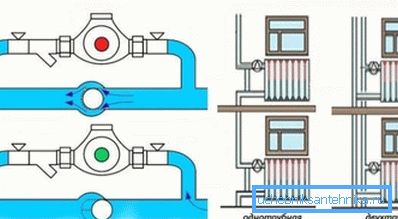
Device Overview
Our readers who love to do everything with their own hands, it will be extremely useful to learn more about him. We will try to avoid complex technical terms so that the features of this important structural element are understandable to the majority.
Bypass is called the jumper between flow and return, made in the form of a pipe segment. Usually it is used for a heating radiator, with its diameter should be less than the diameter of the feed for one size. Most often it is possible to meet pipes on 1/2. Today, such a device has become somewhat different, although its initial capabilities have not been forgotten.
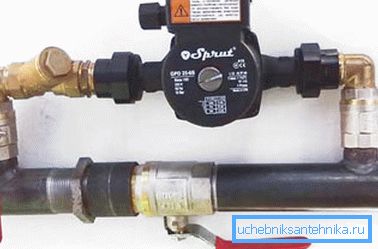
Application
Below we consider the main uses of the device:
| Adjustment of the coolant |
|
| Without electricity | Especially the installation of the device is important for modern heating circuits, where a circulation pump is provided. It gives an answer to the most frequently asked question by consumers in retail chains: “How will the system work when electricity is lost?” For many years the use of standard floor boilers did not provide for their dependence on electricity. However, the use of the heating system of the circulating pump made the units volatile. When the electric power is lost, the instruction recommends cutting off the coolant supply to the pump and opening the valve on the central main pipe. If you equip the device with a valve, this work will be performed automatically. All this needs to be done in order to transfer the system to the natural circulation mode. |
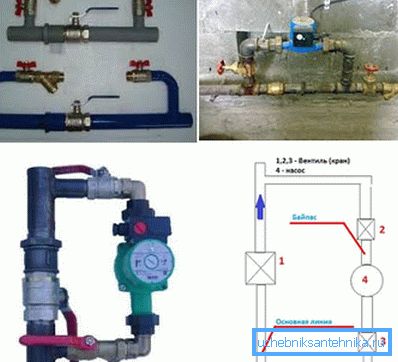
Installation of devices on the bypass must be performed towards the coolant, observing the following sequence:
- filter - serves to delay large and small particles that may appear in the open heating system, entering it from the water supply system. The price of the part is low, but it does a very necessary job;
- check valve - ensures the movement of the coolant in one direction only. When installing it, you must be guided by an arrow on the body, which indicates the direction of flow;
- circulation pump - it is necessary for forced pumping of the coolant through the heating system.
Tip: when installing the bypass into the riser near the circulation pump, you must use a shut-off valve.
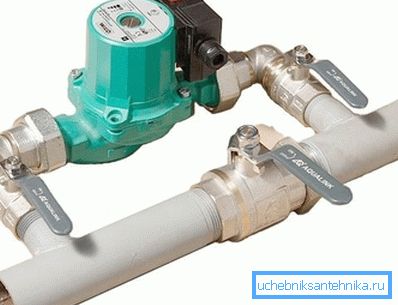
We recommend installing the element horizontally. Then the system will not accumulate air, i.e. she will not be "overwhelmed."
Use in single pipe heating
Such a system is obsolete, but it is still quite often found in the houses of Soviet construction. Sometimes such heating works extremely efficiently, which makes it unbearably hot in the winter in apartments.
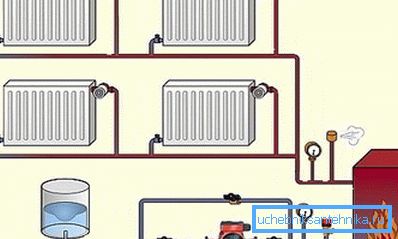
Bypass installation can help in this situation.
The process is simple, however, it is necessary to comply with certain conditions:
- The bypass must be placed at a maximum distance from the vertical section of the pipe. Rather, as close to the radiator as possible.
- The bypass pipe can be made directly at the installation site from the actual pipe, tee, which are connected by welding.
Tip: you can buy an item in a ready-made form and install it using threaded connections.
- Install a thermostat or control valve between the bypass and the inlet of the heating battery. This will allow you to control the temperature in the house. ”
Bypass and energy costs
Installation of the device will reduce energy costs. When compared with the operation of the heating system, where the closing section and the conventional flow section are installed, in the first case the volume of the coolant supplied to the radiator decreases by one third. At the same time, the heat output of the heater is reduced by about 10%.

In practice, these changes will not look dramatic when the system is truly distinguished by an excess of heat. With proper selection of radiator size, there is usually a certain margin of efficiency, amounting to about 10-15%, completely covering the reduction of heat transfer.
Conclusion
As a result, we can say that a simple and primitive at first glance device - a bypass, can rightly be considered universal. With its help, it is possible to create a comfortable living environment in the house, while reducing energy bills, which is good news. Video in the article will provide an opportunity to find additional information on the above topic.